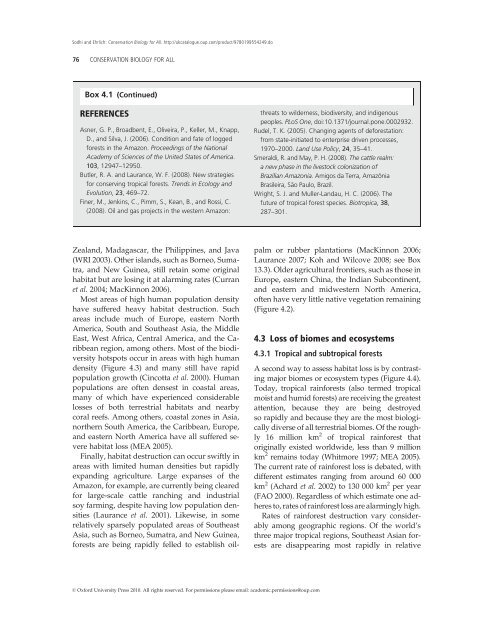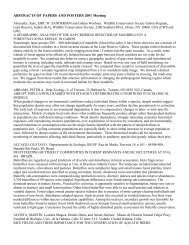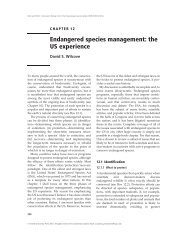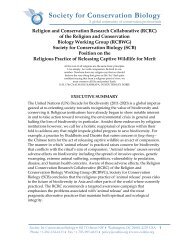Habitat Destruction: Death by a Thousand Cuts - Society for ...
Habitat Destruction: Death by a Thousand Cuts - Society for ...
Habitat Destruction: Death by a Thousand Cuts - Society for ...
- No tags were found...
Create successful ePaper yourself
Turn your PDF publications into a flip-book with our unique Google optimized e-Paper software.
Sodhi and Ehrlich: Conservation Biology <strong>for</strong> All. http://ukcatalogue.oup.com/product/9780199554249.do<br />
76 CONSERVATION BIOLOGY FOR ALL<br />
Box 4.1 (Continued)<br />
REFERENCES<br />
Asner, G. P., Broadbent, E., Oliveira, P., Keller, M., Knapp,<br />
D., and Silva, J. (2006). Condition and fate of logged<br />
<strong>for</strong>ests in the Amazon. Proceedings of the National<br />
Academy of Sciences of the United States of America.<br />
103, 12947–12950.<br />
Butler, R. A. and Laurance, W. F. (2008). New strategies<br />
<strong>for</strong> conserving tropical <strong>for</strong>ests. Trends in Ecology and<br />
Evolution, 23, 469–72.<br />
Finer, M., Jenkins, C., Pimm, S., Kean, B., and Rossi, C.<br />
(2008). Oil and gas projects in the western Amazon:<br />
threats to wilderness, biodiversity, and indigenous<br />
peoples. PLoS One, doi:10.1371/journal.pone.0002932.<br />
Rudel, T. K. (2005). Changing agents of de<strong>for</strong>estation:<br />
from state‐initiated to enterprise driven processes,<br />
1970–2000. Land Use Policy, 24, 35–41.<br />
Smeraldi, R. and May, P. H. (2008). The cattle realm:<br />
a new phase in the livestock colonization of<br />
Brazilian Amazonia. Amigos da Terra, Amazônia<br />
Brasileira, São Paulo, Brazil.<br />
Wright, S. J. and Muller‐Landau, H. C. (2006). The<br />
future of tropical <strong>for</strong>est species. Biotropica, 38,<br />
287–301.<br />
Zealand, Madagascar, the Philippines, and Java<br />
(WRI 2003). Other islands, such as Borneo, Sumatra,<br />
and New Guinea, still retain some original<br />
habitat but are losing it at alarming rates (Curran<br />
et al. 2004; MacKinnon 2006).<br />
Most areas of high human population density<br />
have suffered heavy habitat destruction. Such<br />
areas include much of Europe, eastern North<br />
America, South and Southeast Asia, the Middle<br />
East, West Africa, Central America, and the Caribbean<br />
region, among others. Most of the biodiversity<br />
hotspots occur in areas with high human<br />
density (Figure 4.3) and many still have rapid<br />
population growth (Cincotta et al. 2000). Human<br />
populations are often densest in coastal areas,<br />
many of which have experienced considerable<br />
losses of both terrestrial habitats and near<strong>by</strong><br />
coral reefs. Among others, coastal zones in Asia,<br />
northern South America, the Caribbean, Europe,<br />
and eastern North America have all suffered severe<br />
habitat loss (MEA 2005).<br />
Finally, habitat destruction can occur swiftly in<br />
areas with limited human densities but rapidly<br />
expanding agriculture. Large expanses of the<br />
Amazon, <strong>for</strong> example, are currently being cleared<br />
<strong>for</strong> large-scale cattle ranching and industrial<br />
soy farming, despite having low population densities<br />
(Laurance et al. 2001). Likewise, in some<br />
relatively sparsely populated areas of Southeast<br />
Asia, such as Borneo, Sumatra, and New Guinea,<br />
<strong>for</strong>ests are being rapidly felled to establish oilpalm<br />
or rubber plantations (MacKinnon 2006;<br />
Laurance 2007; Koh and Wilcove 2008; see Box<br />
13.3). Older agricultural frontiers, such as those in<br />
Europe, eastern China, the Indian Subcontinent,<br />
and eastern and midwestern North America,<br />
often have very little native vegetation remaining<br />
(Figure 4.2).<br />
4.3 Loss of biomes and ecosystems<br />
4.3.1 Tropical and subtropical <strong>for</strong>ests<br />
A second way to assess habitat loss is <strong>by</strong> contrasting<br />
major biomes or ecosystem types (Figure 4.4).<br />
Today, tropical rain<strong>for</strong>ests (also termed tropical<br />
moist and humid <strong>for</strong>ests) are receiving the greatest<br />
attention, because they are being destroyed<br />
so rapidly and because they are the most biologically<br />
diverse of all terrestrial biomes. Of the roughly<br />
16 million km 2 of tropical rain<strong>for</strong>est that<br />
originally existed worldwide, less than 9 million<br />
km 2 remains today (Whitmore 1997; MEA 2005).<br />
The current rate of rain<strong>for</strong>est loss is debated, with<br />
different estimates ranging from around 60 000<br />
km 2 (Achard et al. 2002) to 130 000 km 2 per year<br />
(FAO 2000). Regardless of which estimate one adheres<br />
to, rates of rain<strong>for</strong>est loss are alarmingly high.<br />
Rates of rain<strong>for</strong>est destruction vary considerably<br />
among geographic regions. Of the world’s<br />
three major tropical regions, Southeast Asian <strong>for</strong>ests<br />
are disappearing most rapidly in relative<br />
© Ox<strong>for</strong>d University Press 2010. All rights reserved. For permissions please email: academic.permissions@oup.com






